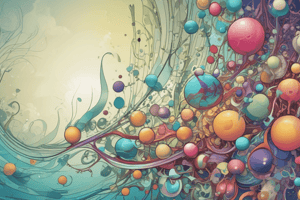Podcast
Questions and Answers
Which of the following best describes pharmacodynamics?
Which of the following best describes pharmacodynamics?
- Drug absorption in the body
- The effect of a drug on the body (correct)
- The effect of the body on the drug
- Drug elimination from the body
Pharmacokinetics describes the toxic effects of drugs.
Pharmacokinetics describes the toxic effects of drugs.
False (B)
What term refers to a chemical substance that can affect a biological system?
What term refers to a chemical substance that can affect a biological system?
drug
A receptor is a protein that receives chemical messages, also known as a(n) _______.
A receptor is a protein that receives chemical messages, also known as a(n) _______.
Match the following terms with their descriptions:
Match the following terms with their descriptions:
What is the first step in cell communication?
What is the first step in cell communication?
In autocrine signaling, a cell sends a signal to a remote cell.
In autocrine signaling, a cell sends a signal to a remote cell.
A receptor is a macromolecule structure made of ______ chains.
A receptor is a macromolecule structure made of ______ chains.
What is another name for a ligand?
What is another name for a ligand?
What is the outcome of a ligand (signaling molecule) binding to a receptor (signal detector)?
What is the outcome of a ligand (signaling molecule) binding to a receptor (signal detector)?
Flashcards
Pharmacodynamics
Pharmacodynamics
The study of how drugs affect the body and their mechanisms of action.
Pharmacokinetics
Pharmacokinetics
Describes how the body affects a drug, including absorption, distribution, metabolism, and elimination.
Drug
Drug
A chemical substance that can affect biological systems, either natural or synthetic.
Cell signaling
Cell signaling
Signup and view all the flashcards
Ligand
Ligand
Signup and view all the flashcards
Cell signaling steps
Cell signaling steps
Signup and view all the flashcards
Receptor
Receptor
Signup and view all the flashcards
Signal transduction
Signal transduction
Signup and view all the flashcards
Types of cell signaling
Types of cell signaling
Signup and view all the flashcards
Study Notes
Lecture 1: Introduction to Pharmacology: Pharmacodynamics
- Pharmacology definition: The study of the interaction between a chemical substance and a living system (pharmakon = drug or poison, ologos = science).
- Drug definition: A chemical substance, natural or synthetic, affecting a biological system (human, animal, insect, or cell).
- Pharmacology subdivisions:
- Pharmacodynamics: Describes the effect of a drug on the body and the mechanism of its action (receptor binding or interactions).
- Pharmacokinetics: Describes the effect of the body on the drug, determining how quickly and to what extent it appears at the target site (absorption, distribution, metabolism, elimination).
- Pharmacotherapeutics: The clinical use and indications for a drug.
- Toxicology: The study of the toxic effects of drugs or toxins.
- Cell signaling: How cells communicate, either electrically (neural transmission) or chemically (ligands, e.g., hormones, neurotransmitters).
- Ligand: A small molecule interacting with a specific receptor site.
- Types of cell signaling (based on distance):
- Autocrine: Signal from a cell to itself.
- Paracrine: Signal from a cell to a neighboring cell
- Endocrine: Signal from a cell to a distant cell.
- Three types of cell surface receptors:
- Ligand-gated ion channels: Ligand binding opens or closes a channel, altering ion flow, leading to rapid response (e.g., milliseconds).
- G protein-coupled receptors (GPCRs): Ligand binding activates a G protein, which in turn activates another enzyme, leading to a cascade of effects with a response time of seconds to minutes.
- Enzyme-linked receptors: Ligand binding activates an intracellular enzyme, leading to a longer response lasting minutes or hours.
- Intracellular receptors (DNA-linked receptors): Lipid-soluble ligands cross the membrane and bind to intracellular receptors which regulate gene expression, resulting in a delayed response (hours or days).
- Drug Affinity: The ability of a drug to bind to a specific receptor (determined by the strength of bonds and their number).
- Drug Efficacy (Intrinsic Activity): The ability of a drug to produce a biological effect, related to the number of drug-receptor complexes formed, with a maximal response reached when all receptors are occupied.
- Non-receptor-mediated effects: Some drugs exert effects via interactions not involving receptors (e.g., antacids, osmotic diuretics).
Studying That Suits You
Use AI to generate personalized quizzes and flashcards to suit your learning preferences.
Related Documents
Description
Explore pharmacodynamics, a pharmacology subdivision describing the effects of drugs on the body and their mechanisms of action. It includes receptor binding and cell signaling. Learn how drugs interact with biological systems.




